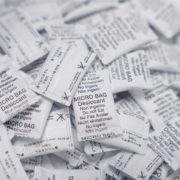Dehydrating Unit
The Problem
Dehydrating bags are generally made using Silica Gel and Dehydrating Clay.
- Silica Gel is a synthetic desiccant obtained by acidifying sodium silicate, followed by washing and drying.
- Dehydrating Clay is a naturally sourced bentonite that is quarried, sieved, and dried.
When produced, stored, and processed correctly, Silica Gel performs consistently (no variations across different batches), with an efficiency of 20% of its weight in grams of adsorbed water vapor (96g) under DIN test conditions of 23°C and 40% RH. For this reason, silica gel bags have always been sold and purchased by weight; two 480g silica gel dehydrating bags, regardless of the manufacturer, will have identical performance, provided both manufacturers use quality silica gel and process and package the product according to industry standardsDehydrating clay, on the other hand, is a natural product, so its performance is not always consistent. Moreover, not all clays meet the requirements for dehydration us.
Dehydrating clay, on the other hand, is a natural product, so its performance is not always consistent. Moreover, not all clays meet the requirements for dehydration use.
A 480g clay dehydrating bag may have variable performance, ranging from 18% to 19.5%, adsorbing between 86.4g and 93.6g of water vapor or, in the worst case, if it is made using unsuitable clay, it may have no effect or even release moisture within the packaging.
o determine the performance of clay dehydrating bags, the user should conduct an absorption test and, each time, request the performance details of the clay used for subsequent supplies.
Obviously, at an industrial level, this process would be impractical, so international production standards have been developed to classify and regulate the production of clay dehydrating bags.
Among the various standards, the concept of the Dehydrating Unit was introduced.
The dehydrating unit is the amount of desiccant needed to adsorb XX grams of water vapor in a climate chamber under 23°C and 40% RH conditions.
DIN MIL NHF
The main standards are:
- NFH 0321: One dehydrating unit equals the amount of desiccant needed to adsorb 100g of water vapor.
- DIN 55473: One dehydrating unit equals the amount of desiccant needed to adsorb 6g of water vapor.
- MIL 3464: One dehydrating unit equals the amount of desiccant needed to adsorb 6g of water vapor.
In other words:
- 1 NFH Unit = 16 DIN Units = 16 MIL Units
- 1/16 NFH Unit = 1 DIN Unit = 1 MIL Unit
Why Introduce the Dehydrating Unit Concept?
When buying or selling a dehydrating bag, it’s always helpful to refer to the dehydrating unit because the aim is to buy or sell not the weight in grams of clay but the weight in grams of water vapor the bag will remove. The bag’s weight may vary (within certain limits), but performance remains consistent.
The Key Takeaway:
When buying a clay dehydrating bag, you are purchasing its final performance (for which the manufacturer is responsible), not its weight in grams.
Levosil tests the performance of each batch (1,000 kg) of raw materials in a climate chamber to ensure that all produced dehydrating bags meet standards.

The “French” NFH standard = Grams of water vapor adsorbed under 23°C / 40% RH conditions = MIL/DIN standard
- 1 NFH Unit = 100g of adsorbed water vapor = 16 MIL/DIN Units
- 1/2 NFH Unit = 50g of adsorbed water vapor = 8 MIL/DIN Units
- 1/4 NFH Unit = 25g of adsorbed water vapor = 4 MIL/DIN Units
- 1/8 NFH Unit = 12.5g of adsorbed water vapor = 2 MIL/DIN Units
- 1/16 NFH Unit = 6.25g of adsorbed water vapor = 1 MIL/DIN Unit
- 1/32 NFH Unit = 3.12g of adsorbed water vapor = 1/2 MIL/DIN Unit
- 1/50 NFH Unit = 2g of adsorbed water vapor = 1/3 MIL/DIN Unit
- 1/100 NFH Unit = 1g of adsorbed water vapor = 1/6 MIL/DIN Unit




